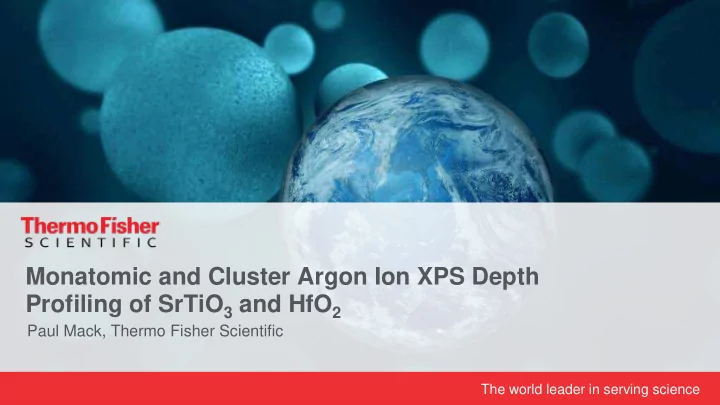

Monatomic and Cluster Argon Ion XPS Depth Profiling of SrTiO 3 and HfO 2 Paul Mack, Thermo Fisher Scientific The world leader in serving science
Introduction: Depth profiling of metal oxide layers • HfO 2 or SrTiO 3 layer on Si substrate • Problem • What is the stoichiometry of the film as a function of HfO 2 or SrTiO 3 depth? ~25 nm • Traditional monatomic Ar+ sputtering causes changes in oxidation state when profiling metal oxides Si • How can we profile through the sample, keeping the Substrate chemistry intact? Argon clusters with ≥2000 atoms are good for profiling • Sample structure through organic layers with minimal chemical damage − These large clusters etch too slowly with inorganic materials 2
Introduction: Monatomic versus cluster profiling • Monatomic ions (Ar + ) • High energy per atom (200eV – 4keV) • High etch rate • Deep surface penetration • Can damage surface chemistry • Ideal for etching inorganic material • Cluster ions (Ar + n ) • Low energy per atom (1eV – 100eV) • Minimal surface penetration • Non-damaging to surface chemistry • Low etch rate for large clusters • Large clusters ideal for etching organic material 3
Introduction: Small clusters for inorganic profiling Energy per atom versus cluster size for different beam energies 100 80 Energy per atom / eV 60 40 Same energy per atom Higher beam 20 energy 8keV beam 0 0 500 1000 1500 2000 Number of atoms in cluster 300 atom cluster 4
Monatomic Argon profile - SrTiO 3 film on Si 500eV Ar + monatomic profile • Monatomic Argon profile 100 Si 90 • 500eV beam energy 80 • Sr:Ti ratio is expected to be 1:1 70 throughout film but ∼ 0.75:1 observed O 60 Atomic % (%) instead 50 • Monatomic Argon beam is modifying 40 the stoichiometry of the film 30 Ti 20 Sr 10 C 0 0 100 200 300 400 500 600 Etch Time (s) 5
Monatomic Argon profile – Titanium chemistry SrTiO 3 film on Si Ti2p spectra as received and during 500eV Ar + sputter profile • Monatomic Argon profile Ti2p 3/2 (Ti 4+ ) • Ti2p spectrum from as received surface shows only peaks due to Ti4 + chemical state (as expected for SrTiO 3 ) Reduced • After only 90s of 500eV Ar + profiling, a oxidation states, caused by ion significant intensity of lower oxidation beam damage states (Ti 3+ , Ti 2+ ) are observed in the Ti2p 1/2 (Ti 4+ ) spectrum • ∼ 45% of the Ti2p spectrum is due to these damaged states after 500eV sputtering 474 470 466 462 458 454 450 Binding Energy (eV) 6
Argon small cluster profile - SrTiO 3 film on Si • Argon small cluster profile + cluster profile 8keV, Ar 300 100 Si 90 • 8keV, Ar300 + small cluster beam 80 • Etch rate is comparable to the 500eV 70 monatomic profile (0.07 nm/s) O 60 Atomic % (%) • With small cluster profiling, the Sr:Ti ratio is much closer to the expected 1:1 value 50 • Small cluster beam is much better at 40 preserving the elemental composition of 30 the SrTiO 3 film, compared to the 500eV Ti 20 monatomic beam Sr 10 C 0 0 100 200 300 400 500 600 Etch Time (s) 7
Argon small cluster profile – Titanium chemistry - SrTiO 3 film on Si Ti2p spectra as received, during 8keV Ar 300 + sputter profile and 500eV monatomic profile • Argon small cluster profile Ti2p 3/2 (Ti 4+ ) • Ti2p spectrum from as received surface shows only peaks due to Ti 4+ chemical state (as expected for SrTiO 3 ) + profiling, the damage • After 90s of 8keV Ar 300 Lower damage from small cluster to the titanium is considerably lower than was profiling observed for the 500eV monatomic beam Ti2p 1/2 (Ti 4+ ) • Small cluster profiling only caused the production of Ti 3+ states, whereas monatomic profiling generated Ti 3+ and the more reduced Ti 2+ state in similar quantities 474 470 466 462 458 454 450 Binding Energy (eV) 8
Low energy (500eV) monatomic Argon profile - HfO 2 film on Si • Significant change in [Hf]/[O] ratio in top few nm, 500eV monatomic Ar + profile caused by preferential sputtering of oxygen 100 Si • Damage to Hf chemistry, as observed in Hf4f 90 spectra (almost 50% on total Hf concentration in film) 80 • Prolonged tailing of Hf damaged into Si substrate 70 O Hf4f spectra from depth profile 60 Atomic % (%) HfO 2 50 40 Hf damaged 30 Hf 12nm 20 Hf damaged 7nm 10 0nm 0 0 10 20 30 30 28 26 24 22 20 18 16 14 12 10 Etch Depth (nm) Binding Energy (eV) 9
Small Argon cluster (8keV, Ar + 150 ) sputter profile - HfO 2 film on Si • Sample tilted to give more glancing ion incidence during sputtering 8keV Ar 150 + cluster profile 100 • Constant [Hf]/[O] ratio throughout film (minimal Si 90 preferential sputtering of oxygen) 80 • No significant damage to Hf chemistry, until well into interface region (much less damage O 70 compared to 500eV monatomic mode) 60 Atomic % (%) Hf4f spectra from depth profile 50 HfO 2 40 Hf 30 20 Hf damaged Hf damaged 12nm 10 7nm 0nm 0 0 10 20 30 30 28 26 24 22 20 18 16 14 12 10 Etch Depth (nm) Binding Energy (eV) 10
Conclusion - HfO 2 film on Si • Small cluster profiling of HfO 2 and SrTiO 3 films • Monatomic and Gas Cluster Ion Source • Comprehensive XPS profiling with small Argon clusters (75-300 atoms) enables HfO 2 films to be analysed with lower chemical damage than monatomic Argon Thermo Scientific Monatomic and Gas Cluster Ion Source (MAGCIS) 11
Recommend
More recommend